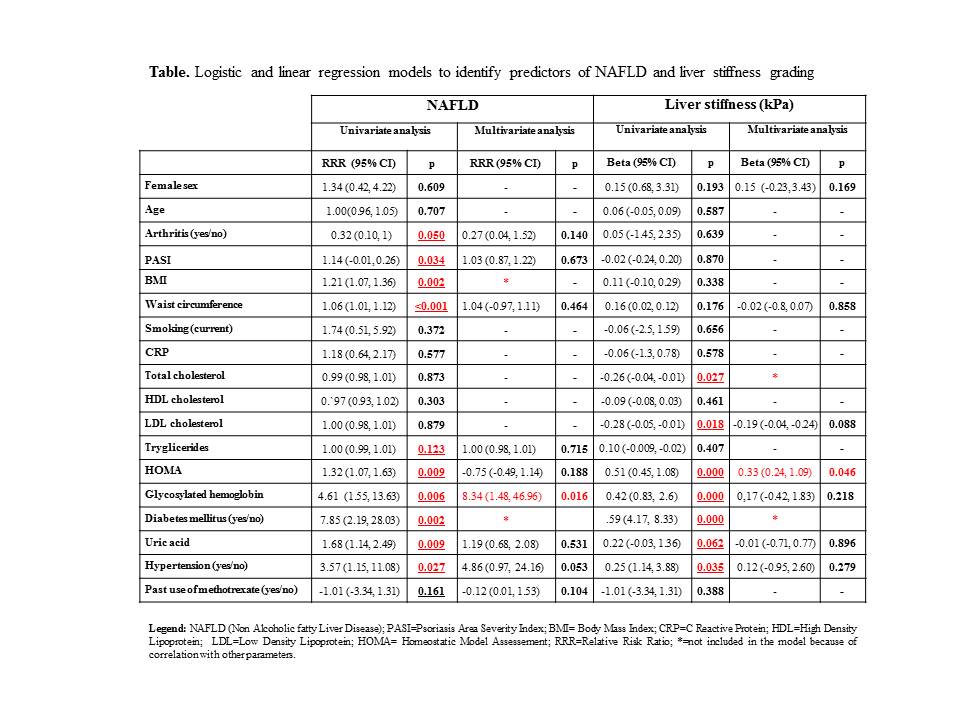Session Information
Session Type: ACR Poster Session C
Session Time: 9:00AM-11:00AM
Background/Purpose: Metabolic syndrome (MetS) and non-alcoholic fatty liver disease (NAFLD, potentially evolving into liver fibrosis-LF), are more frequent in patient with psoriasis (PsO) with respect to general population. Nevertheless, data about psoriatic arthritis (PsA) are lacking. Aims of the study were: 1) investigating if the presence of arthritis, other than PsO, could determine any difference with respect to the prevalence of these comorbidities 2) assess the presence of NALFD and LF and their determinants in PsO/PsA.
Methods: PsA patients with concomitant PsO and PsO patients without history or manifestation of arthritis were consecutively enrolled in the period October 2015-June 2016. Exclusion criteria were: liver diseases potentially causing LF except for NAFLD, alcohol consumption≥20 g/day, daily use of non-steroidal anti-inflammatory drugs, use of methotrexate currently/in the previous year. Anamnestic, biochemical, metrological data were collected, thus defining insulin-resistance index HOMA (Homeostatic Model Assessement) and the presence of MetS. All patients underwent 1) liver ultrasound to assess the presence of steatosis (therefore NAFLD) 2) transient elastography, which measures liver stiffness, to evaluate presence and grading of LF (stiffness≥7 kPa=fibrosis). Disease activity was assessed through Psoriasis Area Severity Index-PASI and Disease Activity index for Psoriatic Arthritis-DAPSA. Statistical analysis included Mann-Whitney and Chi-square test to evaluate differences between PsA/PsO patients, regression analysis to identify predictors of NAFLD and liver stiffness, Spearman’s coefficient to examine correlations; p≤0.05 was considered as significant.
Results: PsA/PsO patients (43/33 individuals) had similar characteristics: age 60.2±8.4/54.5±19.6 years, male 74.4/63%, PsA/PsO duration 12.6±8.5/18.2±14.2 years. Significant differences were found in: Body Mass Index (BMI) (25.7±3.4/29.1±6.3, p=0.0092), PASI (1.5±2.5/5±4, p=0.03556), uric acid (4.9±1.5/5.7±1.4 mg/dL, p=0.0001), all higher in PsO. MetS and LS prevalence was similar between AP/PsO: 34.9%/33.3% and 30.8%/27.6% (p=ns). NAFLD was significantly higher in PsO (64.7% vs 35.3% in PsA, p=0.044). Multivariate regression analysis identified glycosylated haemoglobin as independent predictor of NAFLD (RRR 8.34, p=0.016) and HOMA of liver stiffness grading (beta 0.33, p=0.046) (Table). A strong correlation emerged between uric acid and HOMA (p=0.0001,r=0.80) and uric acid- liver stiffness (p<0.0001,r=0.73) in PsO.
Conclusion: In our study population the prevalence of MetS and LF was similar between PsA/PsO, while NAFLD was more prevalent in PsO. Insuline resistance, which has a key role in MetS, seems the main determinants to liver disease (in terms of NAFLD and LF) in PsA/Ps. In this scenario hyperuricemia could be a relevant co-factor.
To cite this abstract in AMA style:
Ortolan A, Lorenzin M, Tadiotto G, Oliviero F, Hoxha A, Favero M, Piaserico S, Punzi L, Ramonda R. Metabolic Syndrome, NAFLD and LIVER Stiffness in Psoriatic Arthritis and Psoriasis Patients: A CROSS-Sectional Study [abstract]. Arthritis Rheumatol. 2017; 69 (suppl 10). https://acrabstracts.org/abstract/metabolic-syndrome-nafld-and-liver-stiffness-in-psoriatic-arthritis-and-psoriasis-patients-a-cross-sectional-study/. Accessed .« Back to 2017 ACR/ARHP Annual Meeting
ACR Meeting Abstracts - https://acrabstracts.org/abstract/metabolic-syndrome-nafld-and-liver-stiffness-in-psoriatic-arthritis-and-psoriasis-patients-a-cross-sectional-study/

